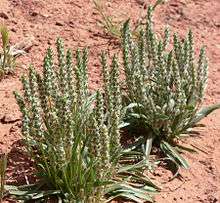Plantago patagonica
Plantago patagonica is a species of plantain known by the common name woolly plantain. It is native to much of North America, including the southern half of Canada, the western and central United States, and northern Mexico, and parts of southern South America. It grows in many types of habitat, including grassland and woodlands. It is a hairy annual herb producing linear or very narrowly lance-shaped basal leaves up to 10 centimeters long. There are usually many stemlike inflorescences growing erect to a maximum height around 18 centimeters. Atop the peduncle of the inflorescence is a dense cylindrical or somewhat conical spike of several tiny flowers and bracts. The spike is very woolly.
| Plantago patagonica | |
|---|---|
 | |
| Scientific classification | |
| Kingdom: | Plantae |
| Clade: | Tracheophytes |
| Clade: | Angiosperms |
| Clade: | Eudicots |
| Clade: | Asterids |
| Order: | Lamiales |
| Family: | Plantaginaceae |
| Genus: | Plantago |
| Species: | P. patagonica |
| Binomial name | |
| Plantago patagonica | |
| Synonyms | |
|
Plantago picta | |
Native Americans (Navajo, Pueblo, Hopi) also used this as a medicinal and ceremonial plant. Navajo and Pueblo Native Americans use it for headaches, diarrhea, babies' colic, and to reduce appetite and prevent obesity.[1]
| Wikimedia Commons has media related to Plantago patagonica. |
References
- M., Burns, Pearl. Wildflowers of the Sandia and Manzano Mountains of central New Mexico. ISBN 1578335299. OCLC 756210704.
